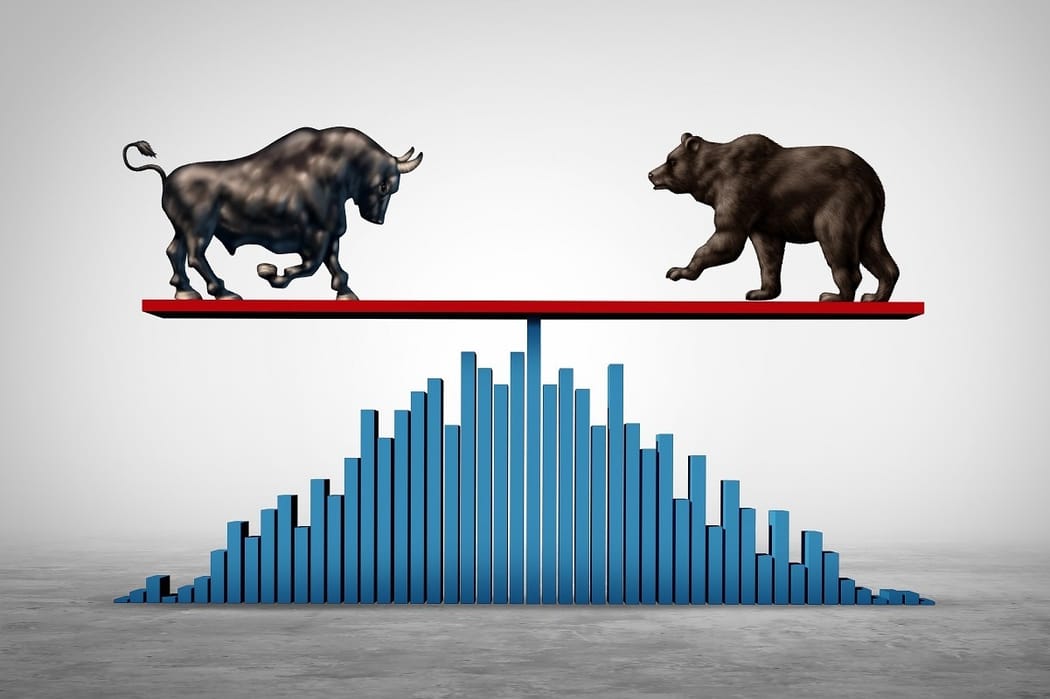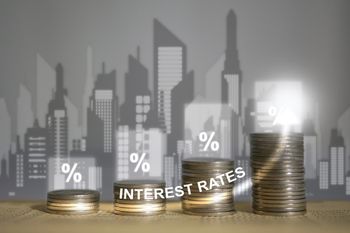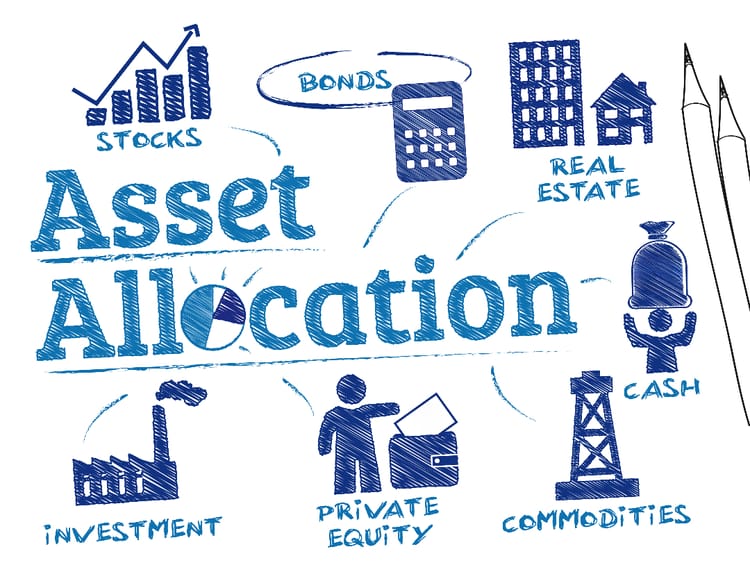You may have heard of the term “bear or bull market” on mainstream media regarding investments. Bull and bear markets are a term used to refer to market conditions as to how investments are doing. Traditionally, it refers to the stock market, but now it can be applied to any other assets. It is important to understand the market conditions because it has a huge impact on your portfolio.
Here, we explore the features of the bull and bear market and predictions:
- What is a bull and bear market?
- Characteristics of bull and bear markets
- How do you determine a bull vs bear market?
- An overview of steps to take during bull and bear markets
- Predictions for bear and bull market in 2021.
What is a bull and bear market?
Bear and bull market refers to the performance of the market. When it comes to the influence they can have on your portfolio and the investing decisions you make, they are two very different beasts. We will explore the “bear and bull” market through analysing their characteristics, differences, and mitigation under each market.
Defining bull and bear markets
A “Bull” is when the market is favourable for investors. The stock market price and company equities increase and bring good returns for investors. There is a strong demand in the stock market for shares and other securities but little supply. Most securities holders are not willing to sell to cash out their profits, leading to an increase in the price of shares. This is because investors have faith in the market that it will keep growing in the foreseeable future. Not only the market conditions are better, but also the overall economy of the state is doing significantly well, with high employment levels.
A bear market is the opposite, where equities lose their value and become more volatile. An example of a bear market was the 2008-09 market crash [1], where the housing bubble burst and led to the downfall of the housing market to a significantly low level. The demand for securities is lower and more investors are looking to sell. In such cases, most investors will lose faith in the market and will sell everything to save the last penny, eventually further driving down the market.
With unemployment levels rising and people refrain from spending, the economy is also affected, impacting company equities negatively because they need consumer spending. For a market to be considered “bear” [2], the price must fall 20% or more.
What is a bear market?
A bear market occurs when the stock values of major market indices fall by at least 20% from their latest peak. While bear markets usually come forth due to economic falls, it does not automatically result in a recession. However, 70% of bear markets resulted in a recession [3].
During a bear market, many investors may desire to sell their investments in order to preserve their money, gain access to cash, or shift their holdings to more conservative securities, which can have the unintended consequence of causing a sell-off, causing stock prices to fall even further. It may also force investors to sell their investments for less than they purchased for them, limiting their ability to meet their long-term financial goals.
Bear markets still occur around every 5.4 years [4]. You should expect to experience around 14 bear markets in your lifetime.
What causes a bear market?
A sluggish economy and growing unemployment rates are frequently the causes of a bear market. During this period, investors are often pessimistic about the stock market's growth, so they sell it, inadvertently resulting in a recession. In such situations, the number of sellers outnumbers the number of buyers.
Bear market phases
There are four phases in a bear market:
- Firstly, once a bear market hits, the first reaction to it usually avoidance because market fluctuation is normal and to take every market fall seriously would result in poor performance if the investors react to it. Almost every time, when markets fall, they also recuperate the losses later. But, some losses are permanent and some falls do not get back up. This is where the second phase hits as bear market creeps in.
- The second phase is panic where investors realise that the market fall was no usual fluctuation but an actual loss. This is where they are tested and as a result most investors will sell to prevent further losses.
- The third phase is where the downward trend stops and the anxiety subsides. But the concerns do not stop as investors realise that markets can decline for a plausible reason, like the pandemic, which must be mitigated to prevent further losses. If they do not, the losses will continue. Investors who have already lost their money will not be able to recover them soon. This stage lasts for a very long time, sometimes years on end.
- The last phase is where your investment finally starts to recover but investors will not realise it until very later because recovery is slow and very few media outlets cover it. But eventually, as basic investment principles dictate, the market recuperates the losses.
What is a bull market?
A bull market occurs when a major stock market index increases by at least 20% from its latest low. During a bull market, stock prices rise steadily, and investors feel confident about the stock market's future success.
Bull markets show that the economy is healthy and that unemployment rates are generally low, which can create even more confidence in investors and offer them with more income to invest. This has the potential to result in tremendous growth. During bull markets, stock values rise 112 percent on average [5].
What causes a bull market?
Unlike bear market, bull markets result from a growing economy with a strong GDP and decrease in unemployment rate. Growing investor confidence is one indicator of bull market as the demand for stocks increase. With stock value increasing, we also see a higher initial public offerings from companies.
Bull market phases
The basic phases of a bull market typically involves rising prices of stocks, at least 20% and more over a short amount of time and it coincides with the growing economy. But this is just the outcome of a bull market.
Similar to the bear market, bull market also has 4 typical phases:
- The first phase starts with the end of a market fall where stock prices have crashed. Opportunistic investors will take advantage of the downfall and buy stocks at a ridiculously low price.
- The second phase is where doubt still remains despite the market growth. While there are no more bad news about the economy, most are still suspicious and unconvinced. Those who have participated in the market by buying up cheap shares, they look at the company's value to its earnings and buy shares when the value of the shares look good.
- In the third phase, the market actually starts getting better as more investors participate. Volatility decreases and buying low strategy becomes popular amongst everyone.
- The fourth phase is overwhelmingly positive as more people start participating in the market. More companies start offering their shares to public to increase their capital.
Characteristics of bull and bear markets
Although the direction of stock prices indicates whether a market is in a bull or bear market, there are certain more features that investors should be aware of:
- In a bull market, there is a high demand for securities and a low supply. As a result share prices climb. In a bear market, more people want to sell than buy. Because demand is much lower than supply, share prices fall.
- Investor's mental state influence whether the market rises or falls because the market's activity is influenced by how the investor will react to the market. During a bull market, investors eagerly join in the prospect of profit. During a bear market, people don't feel good about the market, and investors begin to shift their money away from stocks and into fixed-income instruments as they wait for the stock market to recover. This causes a general price decrease as outflow grows.
- Companies whose stocks trade on the exchanges are also players in the larger economy. A sluggish economy is related with a bear market. Most businesses are unable to generate large profits because consumers do not spend enough. This drop in profitability has a direct impact on how the market values equities. In a bull market, the opposite happens. More people are able to spend money which propels and fortifies the economy.
How do you determine a bull vs bear market?
Market conditions in bull and bear markets are vastly different. The ability to determine whether you are in a Bull market (on the rise) or a Bear market (on the decline) is critical for both traders and investors. And if you can determine when the market shifts from one bias to the other, you may position yourself to profit from a market that is moving up or down.
We'll look at how fundamental and technical analysis may help you determine when the market is 'nearing a turn,' and how you should position yourself to capitalise on that move.
Difference between bull and bear market
The following factors distinguish between a bull and a bear market:
- Stock prices rise in a bull market and fall in a bear market. Under bullish conditions, the stock market consistently gains value, despite some brief market corrections. Under bearish conditions, the stock market loses value or remains stable at low prices.
- A rising GDP indicates a bull market, whereas a falling GDP indicates a bear market. GDP rises when companies' revenues rise and employee pay rises, allowing for higher consumer spending. Bear markets are inextricably related to economic downturns and depressions. Recessions are formally proclaimed when GDP falls for two consecutive quarters, whereas depressions occur when GDP falls by 10% or more and lasts at least two years.
- A falling unemployment rate corresponds to a bull market, whereas a rising unemployment rate corresponds to a bear market. Businesses expand and hire during bull markets, but during downturn markets, they may be obliged to reduce their headcount. A rising unemployment rate tends to extend a bear market since fewer individuals earning pay means lower revenues for many businesses.
- Price inflation can be an issue when the economy is booming, but it can also occur during a bear market. In bull markets, high demand for goods and services can lead prices to rise, while in bear markets, falling demand can induce deflation.
- Low interest rates are often connected with bull markets, whilst high interest rates are typically associated with bear markets. Low interest rates make it more inexpensive for firms to borrow money and grow, but high interest rates tend to stifle company growth.
An overview of steps to take during bull and bear markets
While bull markets rarely create undue stress, bear markets frequently cause anxiety and uncertainty. However, how you handle a bear market depends on your investing horizon.
If you're saving for a long-term goal, such as retirement, try to hold on to your stocks and continue investing in any market. While you may be tempted to sell your investments to avoid further losses during a bear market, doing so locks in your losses. You must then make the difficult decision of when to re-enter the stock market.
Market timing is notoriously tough since you never know when the market will crash. According to Charles Schwab research [6], if you move your investments to cash even for a month while determining if the market has reached its bottom, you could reduce your investment returns by more than 30% compared to someone who stays invested the entire time.
If you are nearing the conclusion of your investing horizon, you have less time to recover from bear market drops. While the market has historically recovered from each bear market, it is possible that your investments will not return to their previous levels in the next few years.
That is why financial advisors advise you to check your portfolio frequently throughout your life to modify your portfolio allocation and rebalance as appropriate. This may imply purchasing or selling various securities in order to maintain a proper mix of stocks, bonds, and cash to satisfy your financial objectives and risk tolerance level.
What should you do in a bull market?
In a bull market, the best course of action is to buy equities early in order to profit from future price increases by selling them at a profit. Growth stocks [7] tend to outperform in a bull market, but value stocks [8] are usually superior buys in bear markets.
Value stocks are often less popular in bull markets due to the idea that "undervalued" stocks must be inexpensive for a reason when the economy is growing. The stock market can be negative even when other asset types are bullish, and vice versa.
If the stock market is up and you're worried about price inflation, allocating some capital to gold or real estate may be a good idea. You should also consider geographically diversifying your interests in order to benefit from bull markets in other parts of the world.
What should you do in a bear market?
You may consider bear markets to be opportunities: When you're young, a bear market allows you to take advantage of cheaper stock prices before the market recovers. And, by dollar-cost-averaging, you reduce the chance of paying more per share than you would otherwise. In fact, you may end up spending less per share in the long run.
While you should avoid selling during a downturn, a bear market may serve as a reminder to reconsider your investment approach once the market recovers. Even if you know the market will return, you may discover that your willingness to take on risk is less than you imagined.
The possibilities of future losses are higher because it is consistently losing value and shows no signs of recovery. Before generating a profit, investors will have to lose more than they can bear. Instead, most experts recommend investing in fixed-income securities.
Absolute losses in a bear market are not definitive, and investors can still profit from a down market by short selling. However, it must be done with caution, and the investor must be willing to accept considerable losses. If the stock market is down, you may want to consider boosting your bond allocation or perhaps converting a piece of your portfolio to cash.
Should you buy in a bear market?
There are arguments for and against buying in a bad market. The reason you would want to buy in a bear market is that there are several opportunities to benefit by purchasing lower-priced equities. The advantages of this method are evident because, historically, equity prices "in the fall", have risen substantially. The potential benefits of this method are considerable.
The following are some of the reasons why you should not buy in a bear market:
- A collective investor's sour outlook on the stock market as a result of panic or other one-time event can sometimes cause a large drop.
- Stock market crashes can trigger a massive economic downturn, causing businesses to close, jobs to be lost, and wide recessions to occur.
- Investors with a negative outlook tend to speculate heavily on the stock market, with the firm confidence that it will, without a doubt, fall in value. However, this speculative behaviour may result in erroneous bets and large losses for investors if the markets do not tend to go in their bearish favour all the time. As a result, if bets go bad, such behaviour could result in massive losses.
Should you buy in a bull market?
There are arguments for and against investing during a bull market.
Some investors feel that regardless of overall price levels, you should always invest in the stock market. In general, if stocks are increasing, they will continue to rise until an event occurs that causes them to halt. For example, the S&P 500 surging more than 28% in 2019 [9]. Stocks can continue to rise in an economic climate of low interest and inflation rates, as well as broad economic and political stability. No matter how high or low the stock market is at any given time, there are always good stocks that are undervalued for any reason. Good equities are more difficult to find in bull markets than in downturn periods. They are, nevertheless, still available, and you can continue to invest profitably by selecting such companies. Even if you are positive that the market is overpriced and due for a correction, you could be dead wrong. Even those with access to massive amounts of technical data are unable to foresee large market shifts.
One of the arguments against investing in a bull market is that every bull market in history has ended in disaster. Markets do not flourish indefinitely, and at some point, loan defaults begin to climb and consumer spending begins to fall. One of the factors that causes bull markets to deflate is that prices grow to the point where participation is no longer an investment, but speculative. This occurs when the primary incentive for people investing in stocks is that prices continue to rise. They aren't very concerned with fundamentals like revenue or profit growth, or even dividends. Rather, it's a matter of catching the right wave. Naturally, it is simpler to buy in a bear market and easier to sell in a bull one. That is when you will make the most money.
Predictions for bear and bull market in 2021
Let us remind everyone once again - You cannot time the market! Yet, people keep looking for patterns where there are none and make decisions based on past performance, knowing that past performance is not an indicator of future performances.
But you can observe the market history to understand its nuances and what circumstances led to the outcome. Bulls do not run forever, and bears do not stay forever. The first thing to determine whether the market is bull or bear is its performance in the long term - whether the prices will rise or fall further. Not all market conditions determine themselves as bull or bear - sometimes, it is in the middle. This happens due to economic stagnation, and it produces no rise or fall in the market.
Regardless, various research papers and media outlets have made their predictions for 2021 [10] based on past research and came up with the following:
- Demand for private equity investments in Europe looks strong because of its founder culture, consumer demand for European goods, and ease of business acquisition. It is expected to remain like that beyond 2021.
- Recovery funds from the government and the central banks are enabling support for small businesses in Europe to make them more resilient to economic crashes, greener and more digital.
- Europe has seen a bull market in 2021 with a 5% increase in the stock market, with the index increasing to 13%. Regional stocks will see an increase of 9.5% on average by the end of 2021.
- Basic resources, oil and gas, and financial equities will generate more returns.
How to survive and prosper in a bear market
There are a few things you can do to survive in a bear market, but they are not decisive. Nonetheless, here are some tips to follow in a bad market:
- One lesson from the 2007-2009 crash is that if you buy index funds in small amounts at regular intervals, your chances of better returns become a reality when the market ultimately recovers.
- If you think a bear market is approaching, another good approach is to purchase affordable short and long-term Puts [11] on the major indices. A put is a type of option that represents 100 shares of stock, has a certain time before it expires worthless, and has a set selling price. If you buy puts and the market falls, the value of your puts will rise because the indexes are declining. Because options increase or fall in value by a much greater percentage than stocks, even a small number of put contracts can counterbalance the losses from your long stock position. You have the choice of selling your puts on the open market or exercising and surrendering the shares. This is a high-risk technique that takes considerable practise before doing it for the first time.
- Precious metals, such as gold and silver, can outperform. Food and personal care stocks, also known as "defensive stocks," typically do well. Begin allocating some of your money to certain sectors, as once a sector performs well, it usually performs well for a long time. Thus, this method can assist investors in allocating appropriately.
Where do investors tend to put their money in a bear market?
Where to put your money during a bear market depends on your financial goals.
One of the safest, but most extreme, ways is to sell all of your investments and either keep cash or invest the proceeds in far more reliable financial products, such as short-term government bonds. By doing so, an investor can lower their exposure to the stock market and thereby mitigate the effects of the raging bear. However, investors lack the skill to accurately time the market. Selling everything, often known as capitulation, might cause an investor to miss out on a comeback and lose money. Short positions can be taken to profit from a falling market in a variety of ways, including short selling, purchasing shares of an inverse ETF, or purchasing speculative put options, all of which will gain in value as the market decreases. It's worth noting that each of these quick solutions has its own set of hazards and restrictions.
A defensive strategy is typically employed by investors seeking to maintain positions in the stock market. This method entails investing in large organisations that have robust balance sheets and a long operational history and track record: Stable, large-cap corporations are less affected by an overall economic or stock market slump, making their share prices less vulnerable to a wider drop. Defensive stocks also include companies that provide the essential needs of businesses and customers, such as food staples, utilities, or suppliers of other basic commodities like toiletries. These organisations are more likely to weather downturns because they have strong financial situations, including a large cash position to fund ongoing operational needs.
Lastly, you can also buy puts as a defensive strategy, or you can buy more equities at lower prices through dollar-cost averaging, both of which has been discussed.
Market changing from bullish to bearish and vice versa
Whether you've been investing in the stock market for 10 years or ten months, your shares are likely to have performed well. Global stock markets have been in a bull market, a period in which shares have risen without substantial interruption. The US market has grown at a rapid pace during the last eight years. The FTSE 100 [12] in the United Kingdom, the DAX Future [13] in Germany, and the MSCI [14] World index have all reached new highs[15].
So, how can investors determine the difference between a bull market correction and the arrival of a bear market, and vice versa? In a recent report, Morgan Stanley Research [16] examined and uncovered certain recurring trends in corrections and market movements in a way that provides investors with historical indicators that change is on the way:
- Credit spreads continue to increase: credit is usually the first to suffer, signalling a negative market months in advance, with government bond yields peaking before equities.
- Equities are surging. Global equities tend to climb more steeply in the run-up to a bear market than in the run-up to a bull market, with developing market equities leading the charge. Among industry sectors, technology, telecoms, and materials tend to perform well late in market cycles. Health care, on the other hand, typically underperforms.
- Bond yields are rising. This is primarily due to the bull market's macroeconomic backdrop, which promotes growth and inflation. However, near the end of the market cycle, yields grow even quicker.
- Emerging market currencies are in charge. Many developing market currencies fare well in the year preceding a bear market. In contrast, during a bull decline, the US dollar normally strengthens against developing market currencies while emerging currencies remain unchanged.
- Commodities continue to be strong. In fact, they typically outperform during bear markets compared to bull markets. Crude oil, gold, and copper have all historically experienced double-digit rises in the year preceding a bear market. Notably, when markets enter bear territory, commodities and crude oil tend to peak ahead of equities.
Summary
A market is said to be bullish when stock prices continue to grow alongside investor confidence, employment, and the general economy. A bear market is the opposite-equity prices fall, inflation and unemployment increase, leading to a general economic downturn. Determining and distinguishing between bull and bear markets requires you to observe the equity price, GDP of the country, unemployment and inflation rates, and interest rates. Depending on your portfolio and your goals, you may choose to be conservative with your investments or go wild. Whether you should buy during a bear or bull market, has its own advantages and disadvantages. But you can survive a downward market if you are smart about your investments.
Bear and bull market has a huge impact on your portfolio, so you need to determine the current market before making any investment decision. The key factor, which you should keep in mind, is what is about to happen in the long term - will the prices increase or go down further? Either way, it depends on your risk tolerance.
Frequently Asked Questions
What is the main difference between a bull and a bear market?
A bull market happens when stock prices rise by at least 20% from a recent low, reflecting investor confidence and economic growth. A bear market occurs when stock values fall by 20% or more, usually alongside higher unemployment and lower consumer spending.
How often do bear markets occur?
On average, bear markets appear every 5–6 years. Investors may face around 14 bear markets during their lifetime. While they often cause short-term losses, markets have historically recovered in the long term.
How should investors act in a bull market?
During a bull market, many investors focus on growth stocks and buy equities early to benefit from rising prices. Diversification across sectors and regions can help balance risk, as bull runs do not last forever.
What should you do during a bear market?
Instead of panic-selling, consider dollar-cost averaging, reallocating into defensive assets like bonds or utilities, or keeping part of your portfolio in cash. Bear markets can also be opportunities to buy quality stocks at lower prices if you have a long-term horizon.
Should I try to time the market?
Most experts agree that timing the market is extremely difficult, even for professionals. Staying invested and maintaining a diversified portfolio usually delivers better long-term results than attempting to guess exact market highs and lows.
List of References
- Source: www.thebalancemoney.com
- Source: www.fool.com
- Source: www.cnbc.com
- Source: www.hartfordfunds.com
- Source: www.cnbc.com
- Source: www.schwab.com
- Source: www.investopedia.com
- Source: www.investopedia.com
- Source: www.cnbc.com
- Source: www.ndtvprofit.com
- Source: www.investopedia.com
- Source: www.londonstockexchange.com
- Source: liveindex.org
- Source: www.msci.com
- Source: scottandterry.com
- Source: www.morganstanley.com






